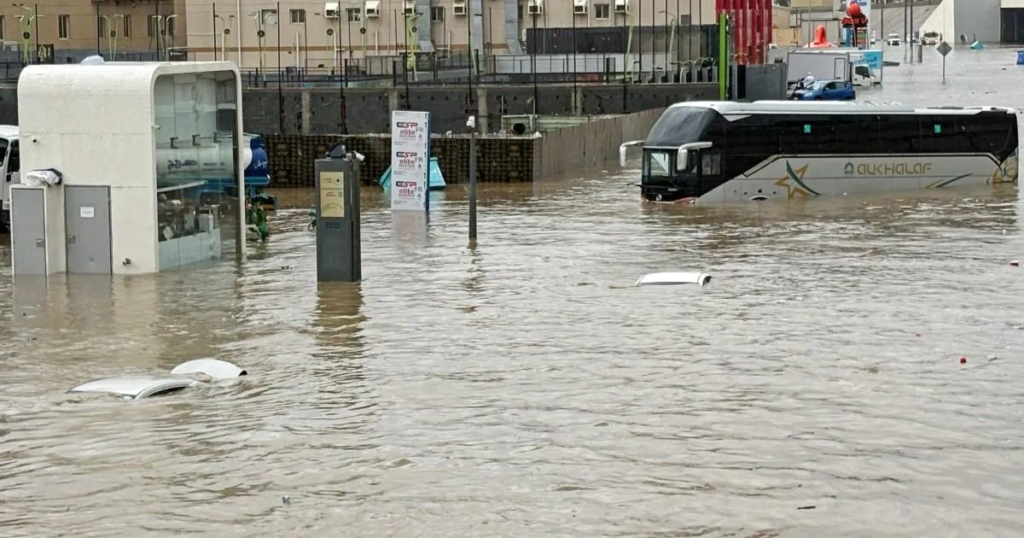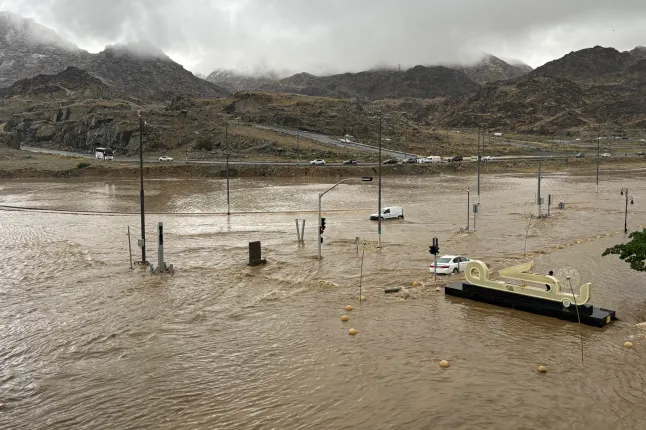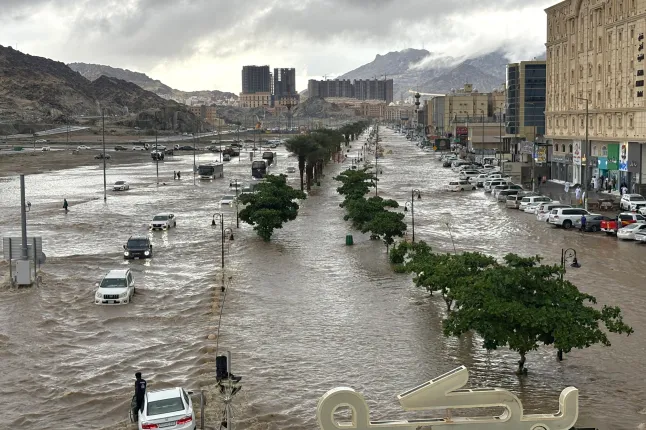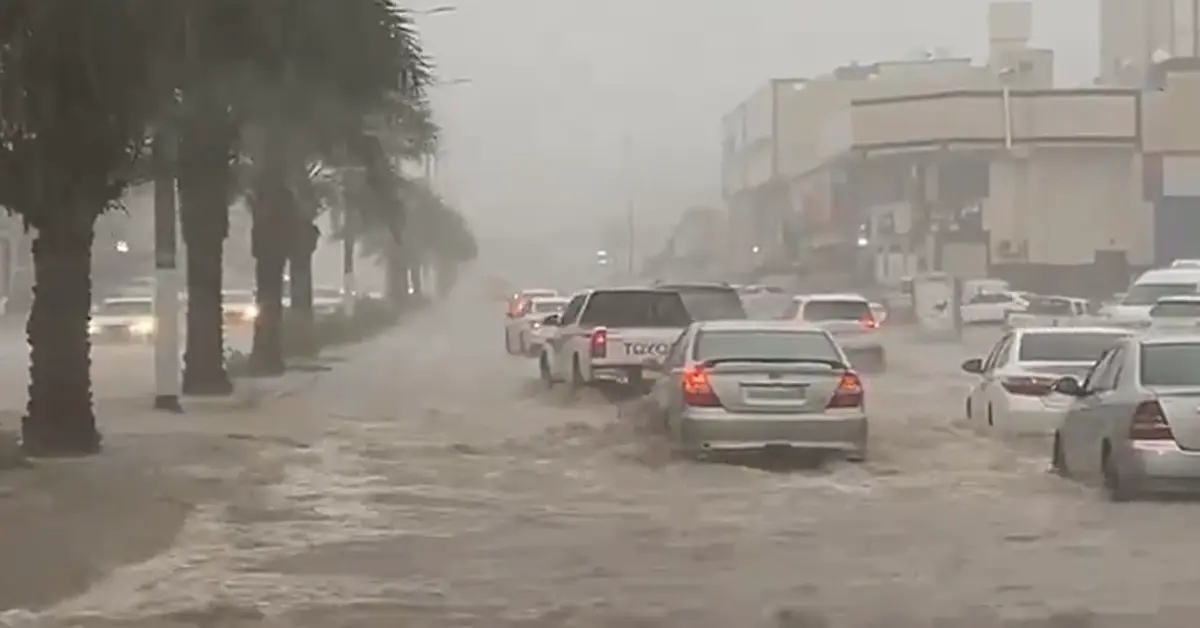Saudi Arabia, known for its vast deserts and dry climate, is witnessing a weather anomaly of staggering proportions. Heavy rainfall has drenched Mecca, Jeddah, and Madinah, flooding streets, halting daily activities, and posing serious challenges to residents and authorities alike.
As snow falls across much of the Northern Hemisphere, Saudi Arabia is battling one of its most extreme rain events in recent history, bringing into sharp focus the region’s vulnerability to changing climate patterns.
Mecca Flooded by Excessive Rain
The flooding in Mecca, one of Islam’s holiest cities, has been severe. Streets are inundated, vehicles have been swept away, and homes and businesses have been submerged under water. Videos circulating on social media depict the extent of devastation, with water gushing through urban areas and even iconic sites struggling against the deluge.
Madinah’s Al-Shafiyah area recorded the highest rainfall at 49.2 mm, while Jeddah’s Al-Basateen district saw 38 mm of rain. These figures, though seemingly moderate, are extraordinary for a region where rainfall is scarce.
The National Meteorological Centre (NMC) has issued red alerts for Mecca, Jeddah, and Madinah, cautioning against thunderstorms, heavy rainfall, and strong winds expected to persist for several days.
The floods have disrupted daily life in profound ways. Schools have been forced to close, transitioning to online learning to ensure student safety.
Public spaces have been shut down, and businesses are grappling with waterlogged premises. Transportation has come to a standstill in many areas, with buses stranded in floodwaters and cars swept away by strong currents.
Read : Pakistan Puts 4,300 Beggars on No-Fly List After Threat from Middle Eastern Countries
Rescue operations have been widespread. In one video, men formed human chains to rescue children trapped by floodwaters in the Al-Awali locality of Mecca. Another clip showed a man heroically saving a delivery driver who had fallen off his motorcycle and was struggling to regain balance against the rushing water.
Streets were flooded and cars submerged as heavy rainfall and waterspouts hit Saudi Arabia's holy city of Mecca. pic.twitter.com/mjAk8Ufd2x
— Al Jazeera English (@AJEnglish) January 7, 2025
These acts of courage underscore the human spirit in times of adversity but also highlight the peril residents face daily during such weather events.
Urban Infrastructure: A Long-Standing Weakness
The recent flooding has exposed glaring weaknesses in Saudi Arabia’s urban infrastructure, particularly in rapidly growing cities like Jeddah and Mecca. Despite the Kingdom’s immense wealth and investments in urban development, drainage and sewage systems in many areas remain underdeveloped.
Jeddah, in particular, has a history of devastating floods. In 2009, the city experienced one of its deadliest flood events, which claimed over 100 lives and caused extensive property damage. The current flooding raises concerns about the city’s preparedness and resilience, as similar patterns of waterlogging and infrastructure collapse are being reported.
The problem lies in the region’s rapid urbanization and insufficient planning to account for extreme weather events. Drainage systems designed decades ago cannot cope with the increasing frequency and intensity of rainstorms.
Experts point out that urban planning in Saudi Arabia has often underestimated the potential impact of heavy rainfall, focusing instead on addressing more immediate challenges posed by the arid climate.
The Role of Climate Change in Extreme Weather
The recent rains in Saudi Arabia are part of a broader trend of increasingly extreme weather events across the globe. While snow blankets much of Europe, Asia, and North America, the Arabian Peninsula is grappling with heavy rain and floods—a stark reminder of the unpredictable shifts brought on by climate change.
Global warming has led to more frequent and intense weather patterns, including excessive rainfall in regions unaccustomed to it. Warmer air holds more moisture, resulting in heavier downpours. Coupled with inadequate infrastructure, these downpours can wreak havoc in urban areas, as seen in Mecca, Jeddah, and Madinah.

Earlier in April 2024, Gulf states, including Saudi Arabia, experienced record-breaking rainfall that caused widespread devastation. In Oman, 21 lives were lost, while the UAE recorded its highest rainfall in 75 years, claiming four lives. These incidents, combined with the ongoing floods, emphasize the urgent need for climate resilience in the region.
A particularly concerning phenomenon during the current rains was the extreme waterspout recorded in Rabigh, described as the strongest ever observed in Saudi Arabia.
This rare occurrence, marked by a swirling column of water reaching the shoreline, caused massive waves and disrupted coastal activities. Such events are becoming more frequent and severe, highlighting the urgency of addressing climate challenges.
The Broader Implications for Saudi Arabia
The impact of these floods extends beyond immediate damage to property and infrastructure. They pose significant economic and social challenges for Saudi Arabia.
Cities like Mecca and Jeddah are critical to the Kingdom’s economy, serving as hubs for tourism, commerce, and religious pilgrimage. Prolonged disruptions due to floods could harm these sectors and undermine public confidence in local governance.
Mecca, as the spiritual center of Islam, attracts millions of pilgrims annually. Any disruption to its infrastructure has global implications, affecting Muslims worldwide who plan their visits during the Hajj and Umrah seasons. Ensuring the safety and accessibility of the city during such events is a critical priority for the Saudi government.

In Jeddah, which serves as a gateway for many pilgrims and a key commercial center, the floods have again raised concerns about urban resilience. While authorities have activated municipal teams to address waterlogging and repair infrastructure, these measures remain reactive rather than proactive.
Looking Ahead: Building Resilience
The ongoing floods are a wake-up call for Saudi Arabia to prioritize sustainable urban planning and climate adaptation measures. Investments in modern drainage systems, flood barriers, and green infrastructure can mitigate the impact of future floods. Additionally, incorporating climate resilience into urban planning policies can help cities like Mecca and Jeddah cope with extreme weather events.
Public awareness campaigns about flood risks and safety measures can also play a crucial role in minimizing casualties during such events. Encouraging community participation in disaster preparedness can enhance the effectiveness of rescue and relief operations.
Saudi Arabia’s Vision 2030, which emphasizes economic diversification and sustainable development, provides an opportunity to integrate climate resilience into its urban development projects.

By leveraging advanced technology and innovative solutions, the Kingdom can build cities that are not only modern but also capable of withstanding the challenges posed by a changing climate.
The floods in Mecca, Jeddah, and Madinah are a stark reminder of the growing unpredictability of global weather patterns. While the immediate focus remains on rescue and relief operations, the long-term solution lies in addressing the root causes of such vulnerabilities—urban planning, infrastructure development, and climate adaptation.
As Saudi Arabia continues its journey toward modernization and diversification, ensuring the safety and resilience of its cities must be a top priority.
The lessons from these floods should serve as a catalyst for change, prompting action that safeguards lives, protects livelihoods, and preserves the sanctity of the Kingdom’s holiest cities.
let’s enjoy few years on earth with peace and happiness….✍🏼🙏

